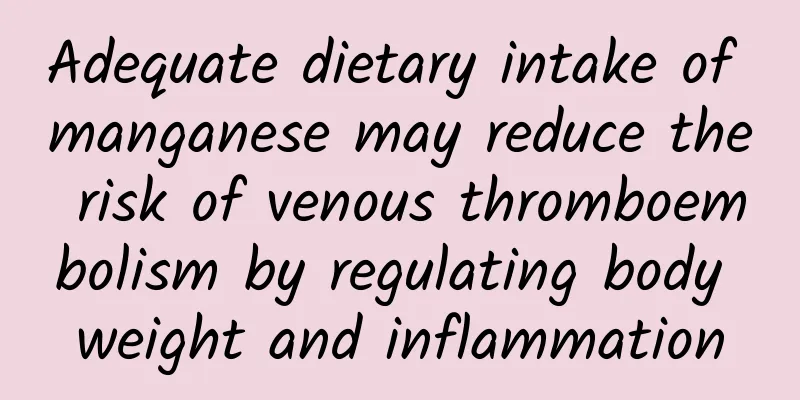Adequate dietary intake of manganese may reduce the risk of venous thromboembolism by regulating body weight and inflammation

|
Venous thromboembolism (VTE), including deep vein thrombosis (DVT) and pulmonary embolism (PE), is the third most common vascular disease after acute myocardial infarction and stroke, with approximately 10 million new cases of VTE each year worldwide. Therefore, identifying more modifiable risk factors to strengthen primary prevention of VTE has important clinical value and public health significance. Manganese (Mn) is an essential trace mineral element for the human body, and its main source is dietary intake. Manganese is involved in a series of physiological and pathological processes related to blood coagulation and vascular injury, including oxidative stress, platelet aggregation, activation of coagulation factors, and endothelial cell dysfunction. However, to date, the prospective association between dietary manganese intake and VTE risk and the potential mechanistic pathways remain unclear. (The picture comes from the Internet, the copyright belongs to the original author) In response to the above clinical problems, a recent study published in the journal Thrombosis and Haemostasis found that dietary manganese intake was negatively correlated with the risk of VTE, and this negative correlation was mainly mediated by obesity, inflammatory biomarkers, and red blood cell distribution width . Professor Qin Xianhui from the National Clinical Research Center for Kidney Diseases, Nanfang Hospital, Southern Medical University is the corresponding author of the article, and Master's student Huang Yu and Doctoral student Zhang Yanjun are co-first authors. The study included 202,507 middle-aged and elderly participants from the UK Biobank who had complete dietary data and were free of venous thromboembolism at baseline. Detailed dietary intake was collected using a 24-hour dietary assessment questionnaire, and the total energy and various nutrient intakes of each subject were calculated based on the UK Nutrition Database food composition tables. During a median follow-up of 11.6 years, 4750 (2.3%) participants developed VTE. Overall, an increase of 1 mg/day in dietary manganese intake was associated with a significant 8% reduction in the risk of VTE, 7% in the risk of DVT, and 9% in the risk of PE (Figure 1). Figure 1 Association between dietary manganese intake and the risk of VTE (A), DVT (B) and PE (C) In addition, BMI, waist circumference, C-reactive protein, white blood cell count, red blood cell distribution width, and physical activity significantly mediated the negative correlation between dietary manganese intake and the risk of VTE, with the mediation proportions being 36.0%, 36.5%, 4.3%, 4.2%, 1.6%, and 1.6%, respectively (Figure 2). Figure 2 The mediating effect of obesity and inflammation In conclusion, our study suggests that adequate dietary manganese intake can reduce the risk of venous thromboembolism by regulating body weight and inflammation . Our findings once again highlight the important role of nutrition in vascular diseases. There are thousands of health strategies, but eating well is the most important. Reasonable diet and scientific nutrition are the cornerstone and core of effectively promoting group health and achieving active health. Information Point - Risk Factors for Deep Vein Thrombosis (The picture comes from the Internet, the copyright belongs to the original author) References: Huang Y, Zhang Y, Yang S, Xiang H, Zhou C, Ye Z, Liu M, He P, Zhang Y, Gan X, Qin X. Association and Pathways between Dietary Manganese Intake and Incident Venous Thromboembolism. Thromb Haemost . 2023 Dec 27. Editor | Zhang Yanjun, Huang Yu, Xianghao Audit | Qin Xianhui |
Recommend
Does ovulation usually occur during the day or at night?
Mothers have a very hard time during pregnancy, b...
The menstrual flow is very small and it stops in two days.
Menstruation is affectionately called "Aunt ...
What are the early symptoms of fungal vaginitis?
According to current medical knowledge, candidal ...
Are there any side effects of always taking painkillers for migraine?
《Cotton Swab Medical Science Popularization》 Wang...
HPV high risk symptoms in women
HPV virus infection is also called human papillom...
Does blood donation lead to infectious diseases, anemia? Is it harmful to the body? 6 blood donation rumors, read them in one article!
Blood is a very important component of the life-s...
Is cervical squamous cell carcinoma fatal?
Cervical squamous cell carcinoma is a malignant t...
What food is best for women with kidney deficiency?
Kidney deficiency is an increasingly common probl...
What is the cause of dull pain in the lower right side of the uterus?
A woman's uterus is a very important organ in...
53-year-old woman with bleeding again three years after menopause
We all know that women have menstruation every mo...
What to do if an unmarried woman has gynecological inflammation
For female friends, the body is relatively weak, ...
How much amniotic fluid is normal for eight and a half months of pregnancy
At eight months of pregnancy, the amniotic fluid ...
What causes ovarian shrinkage?
The ovaries play an irreplaceable role in women&#...
Youth is not discounted, and young people must also learn to stay away from osteoarthritis!
Author: Cao Jiangang, Chief Physician of Tianjin ...
Check endometrial thickness after abortion
Female friends who have had an abortion will defi...









